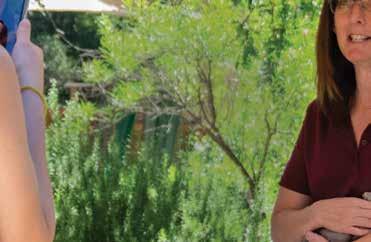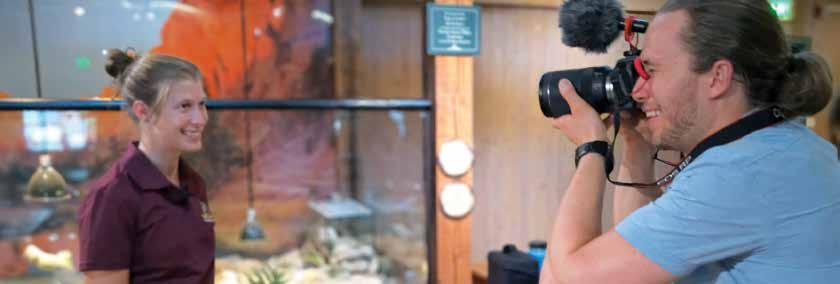
7 minute read
Keep in the Loop with Turtle Bay TV

lights camera action
KEEP IN THE LOOP WITH TURTLE BAY TV
TURTLE BAY TV might be the biggest Redding success story you’ve never heard. When the whole state locked down months ago, the gates to the gardens had to close, as well as the door to the museum, blocking the public not only from the art and science displays in the galleries, but access to the whole park just outside that back door.
Yet, happily, it turns out the public still has access to these Turtle Bay attractions. Not by pushing handles of doors touched by hundreds of random hands, nor by packing into themed rooms featuring interactive educational exhibits, but by kicking back at your computer at home, or calling up the internet on your phone from anywhere to access programming from all four corners of Turtle Bay Exploration Park.
Since April, staff have provided two distinct online routes of access to the treasures of Turtle Bay, according to Seth McGaha, marketing and public relations manager. “We have been busy producing highproduction-value content, as well as candid live streaming on social media,” he says. The former is Turtle Bay TV, 22-minute clips on a variety of topics. Visitors may access

this programming through the Turtle Bay website.
The second route is a series of short livestreams directly to social media, organized and executed by the heads of departments in the park. Marketing specialist Ryan Odle says the Horticulture Department, Education, Exhibition and Animal Care do their own live segments, while Turtle Bay TV represents a more formal production, coordinating with these four department heads to include some content from each for every Turtle Bay TV video.
“Seth and I make a two-man film crew,” says Odle. “Even before the closure, it was already on our minds to do something like this. The closure just pushed that goal into high gear. We brought our park back to life virtually. We still entertain, still teach. People can still learn about animals.”
With only a digital camera equipped with microphones, Odle takes aim at animal trainer Rachel Skrobot inside the Mill House to demonstrate how easily his rig can capture a video session to be edited into an episode of Turtle Bay TV. Meanwhile, just outside the building, Animal Care livestreams their individual public offering, an episode called “Animal Adventures sponsored by Cal Trout.” 4 continued on page 48
On cell phone camera, Sharon Clay, curator of animal programs, introduces to social media the newest member of the Animal Care family, a five-week-old grey fox kit, a rescue found by and kept with people too long to safely return to the wild. Clay speaks without a script, and in the familiar Turtle Bay delivery that encourages audience participation.
“She cannot be returned to the wild because she thinks humans are safe,” stresses Clay. “That’s not safe for her. Because if she comes running and jumps on the back of your child because she thinks they’re someone to play with, you might not be so friendly with this fox.” Moments later she identifies the grey fox as arboreal. “Question out there, what is arboreal?”
Two animal trainers with smartphones comprise the production team that interfaces with the live, online audience. Kyla Forester trains her phone’s camera on Clay; Skrobot watches the live feed on her phone for reactions from the public.
In this case, first sight of the baby fox elicited expressions of “cute” – with hearts – and at least one squeal. Later, Skrobot relays the answer: “It means they’re comfortable in the trees.” In total, the stream lasts about 10 minutes.
Off camera, Clay speaks about another change Animal Care made to adapt to the lockdown. “A big one, we wear masks,” she says. “Some species have been shown to be susceptible to the coronavirus, so we have to be very careful. Our worst nightmare is to get the animals sick.”
Animal trainer Jonelle Meyer says much of the daily routine is like off season. “Some of the animals are enjoying extra time with staff,” she says. “But some of the more personable ones miss our guests.” She notes that trainers can tell this by observing them during the shows. They’ve seen their kookaburra and badger both pay particular attention to the reactions they get from their audiences.
Without this stimulation, the animals’ nervous energy goes up, a behavioral trait that might sound familiar to readers facing a third month of shelter in place.
Greenville Rancheria HEALTH WISE Injury prevention is crucial to the 574 federally recognized American Indian and Alaska Native’s (AI/ANs) tribes in the United States and 109 in California, the most in any state in the nation. Injuries are the leading cause of death for AI/ANs from ages one to 44 and the third leading cause of death overall. Unintentional injury mortality rates for AI/ANs are approximately 2.5 times higher than all U.S. combined races. This varies by Indian Health (Definition) Unintentional injuries — the injury occurs in a short period of time-seconds or minutes, the harmful outcome was not sought, or the outcome was the result of one of the forms of physical energy in the environment or normal body functions being blocked by external means, i.e., drowning. The most common unintentional injuries result from motor vehicle INJURY PREVENTION
Services (IHS) regional area and by cause of injury, according to IHS, an crashes, falls, fires, and burns, drowning, poisonings and aspiration. agency within the Department of Health and Human Services. Aspiration means you’re breathing foreign objects into your airways.
Effective community-based injury prevention initiatives use multiple Understanding the culture of individual AI/AN communities is vital to strategies to reduce and prevent injuries and fatalities. The IHS injury planning and implementing injury prevention programs. It is important program promotes building the capacity of Tribes and communities by for the health care team to be aware of their community’s history, increasing understanding about the injury problem, sharing effective traditional health and wellness practices, political structure, community solutions, and assisting communities in implementing programs. As a infrastructure, demographics, and lifestyle. Our Community Health result of these efforts, unintentional injury deaths to AI/ANs, while still Representatives (CHRs) build a rapport with the community and establish high, decreased by 59%. that trust and relationship. (Definition) Unintentional —“Unintentional is used to refer to injuries that were unplanned.”
Marketing Specialist Odle sees Turtle Bay TV and the live showings as the best way for the public to keep in touch. “They could see that even during the closure Turtle Bay had so much going on,” he says. “They knew we were still active and eagerly waiting to open back up.”
Clay has received encouraging feedback about the streams from the public. “We’ve heard that some parents are using ‘Animal Adventures’ to teach their children at home school,” she says. “They say, ‘It’s exciting, fun and educational, and everyone should tune in.’” Speaking for herself, she adds, “It’s worth your time.”•

Turtle Bay TV • www.turtlebay.org/watch Find Turtle Bay Exploration Park on Facebook (530) 243-8850
Richard DuPertuis is a Redding grandfather who writes. His stories and photographs have appeared in newpapers, magazines and online. He strives for immortality not by literary recognition, but through diet and exercise. He can be reached at dupertuis@snowcrest.net
Greenville Rancheria
How can we educate our community? 1. By promoting comprehensive education through events, such as health fairs, and Home Visits by CHRs. 2. Educating the community on the following subjects such as: Child/Infant Car Seat Safety, bicycle helmet use, life jacket safety, fire safety, and fall prevention.
Increasing understanding about injury problems and sharing effective solutions are key to helping reduce injuries, the “Goal” is to reduce the number of injuries amongst our community members. If you have questions and or concerns, please contact our CHRs for further assistance (530)528-8600. HEALTH PROGRAMS Family Practice Pediatrics Medical Facilities Dental Facilities Medical transport within Plumas and Tehama Counties Community Health Representatives Indian Child Welfare Worker Diabetes Services Mental Health Services Drug, Alcohol and Family Counselor Addiction and Medication-Assisted Treatment 8 Sub-specialties:
Women’s Health, Internal Medicine,
Orthopedics, Physical Therapy,
Psychiatry, Cardiology,
Pulmonology and Pain Management
Se Habla Espanol
PARTICIPATING IN COVERED CALIFORNIA AND MEDI-CAL MANAGED CARE
AS A COURTESY, WE WILL BILL MOST INSURANCES
NATIVES AND NON-NATIVES
Open for Walk-ins. 8am – 5pm. Medical every Saturday, 8am - 5pm and Dental every Saturday, 8am - 4:30pm
Call clinics first to confirm hours of operation due to the COVID-19 pandemic. Dental Greenville closed, Dental Red Bluff emergencies only!









